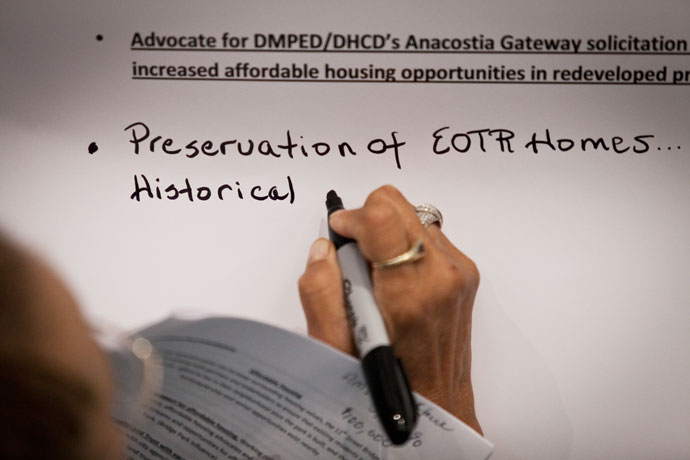
<p><em>Illustration by OMA+OLIN, courtesy of Scott Kratz</em></p>
The vision for DC’s 11th Street Bridge Park, a new $45 million elevated park that will span the Anacostia River, is ambitious: create recreational and environmental value for the city, and connect distressed neighborhoods on the east side of the river to the more affluent neighborhoods on the west side. But to realize this vision, planners must honestly answer, who is this for?
Projects that attempt to revitalize distressed areas almost always confront two tensions: improving the economic prospects of low-income people without also improving the places in which they live, and bringing new economic value to distressed places without also displacing the poor people who live there. In short, these projects face a problem of ensuring equity. In a new series of reports, the Urban Institute is documenting how planners of the 11th Street Bridge Project are addressing these tensions.

Residents of Washington, DC attend a public stakeholder session at the R.I.S.E Demonstration Center, regarding the 11th Street Bridge project on June 27, 2015. Photo by Becky Harlan.
The park’s vision has already attracted significant attention from a wide range of stakeholders, including those with the financial capital to contribute to the bridge’s construction and to other projects in nearby neighborhoods. It has also attracted attention from the mostly low-income, African American stakeholders who already live in the park’s prospective shadow. These stakeholders may not have much financial capital to contribute, but they are very aware of DC’s checkered history when it comes to racial and economic exclusion. They want to know: who is this park really for? Can it really attract new growth and new visitors to the neighborhood while also adding value to their lives and those of the other families who already live there?
Bridge Park director Scott Kratz has said he will consider the park a failure if the eventual answer to “who is this really for?” isn’t both current and future residents of the park’s impact area. Kratz hopes residents will enjoy the park’s amenities, but he also hopes the park will bring expanded affordable housing options, good jobs, and home-grown businesses.
That’s why he and other Bridge Park planners are taking an equity-first approach. The 11th Street Bridge Park Equitable Development Plan, published before the team has raised even one dime for development, documents leaders’ commitment to equity. Kratz and his team have also worked with the Urban Institute to create metrics for measuring equity as they proceed with building the bridge. These metrics are detailed in our report, which also describes some signs that, at least so far, what is getting measured is getting done.
 Residents help shape and define recommendations for the Equitable Development Plan during a public stakeholder meeting on June 27, 2015. Photo by Becky Harlan.
Residents help shape and define recommendations for the Equitable Development Plan during a public stakeholder meeting on June 27, 2015. Photo by Becky Harlan.
It’s still early days for the Bridge Park effort, but eventually, the project might provide a new model for raising both a bricks-and-mortar project and the lives of the people who live nearby.
While you wait for the bridge and more important findings that will come as the equitable development process proceeds, ponder this: If a new public space is not explicitly for the people who lived there before it was built, who is it for? The answer to that question may tell us a lot about the importance of planning for equity first.
Let’s build a future where everyone, everywhere has the opportunity and power to thrive
Urban is more determined than ever to partner with changemakers to unlock opportunities that give people across the country a fair shot at reaching their fullest potential. Invest in Urban to power this type of work.